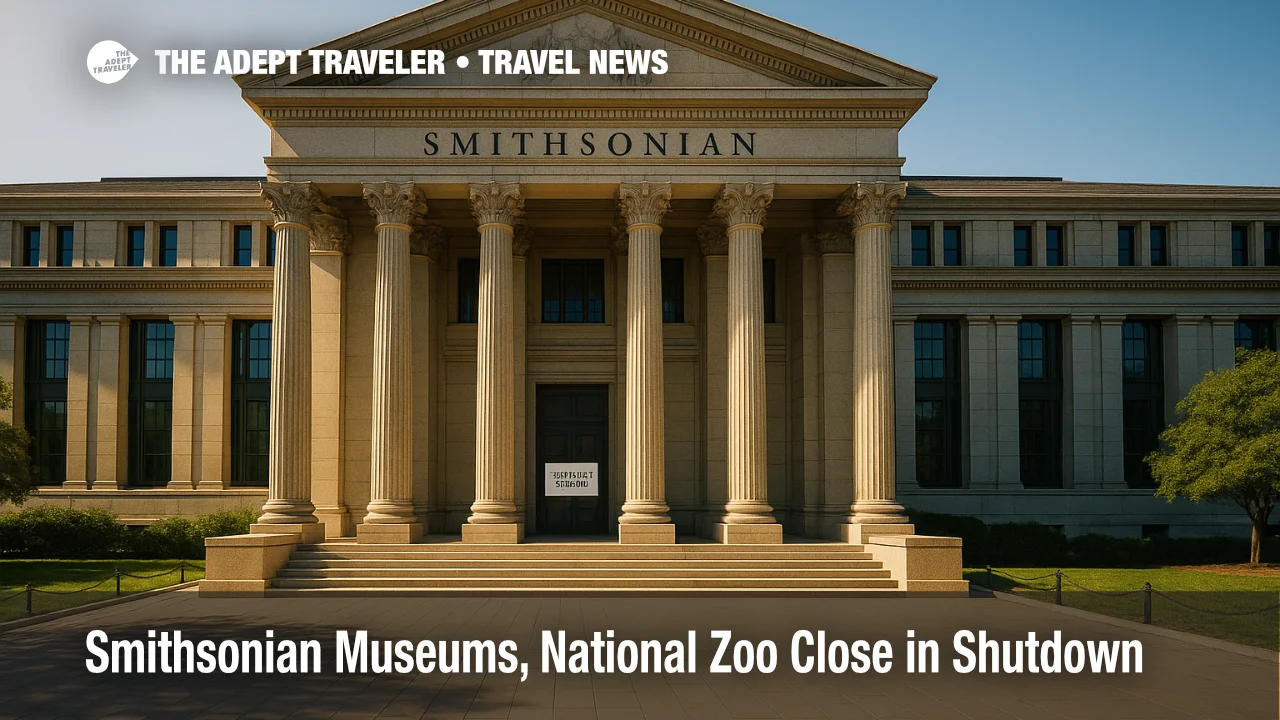Smithsonian museums, National Zoo close in shutdown

The Smithsonian Institution has shuttered all 21 museums, research centers, and the National Zoo after operating on carryover funds since the federal shutdown began on October 1. Those prior-year funds were exhausted, prompting closures that took effect on October 12. The Smithsonian drew 16.8 million visitors in 2024, so darkened galleries and a closed zoo will weigh on fall travel to Washington, D.C., while major industry groups warn that the shutdown is already eroding tourism spending nationally. Digital resources remain available, though the zoo's live animal cameras are offline.
Key points
- Why it matters: The nation's largest museum complex closed October 12, reducing marquee demand drivers in Washington, D.C.
- Travel impact: Free Smithsonian attractions, including the National Zoo, are unavailable until funding is restored.
- What's next: Reopening depends on congressional action to end the shutdown.
- Smithsonian operated through October 11 using prior-year funds before closing.
- Industry estimates point to at least $1 billion in travel losses, and rising.
Snapshot
The Smithsonian confirms that museums, research centers, and the National Zoo are temporarily closed due to the federal government shutdown. The institution had used prior-year funds to stay open through October 11, but those funds are now depleted, triggering closures effective October 12. During the shutdown, essential animal care continues at the zoo, while public-facing amenities such as live webcams are paused. For visitors, the closures remove a cornerstone of Washington, D.C.'s free cultural offerings at the height of fall travel. Destination alternatives remain, but travelers should verify operating status for any federally funded sites and plan extra time around other shutdown-related slowdowns.
Background
The Smithsonian is the world's largest museum complex, comprising 21 museums and the National Zoo across Washington, D.C., and New York City. Eleven museums line the National Mall, and most Smithsonian sites typically offer free admission, a key driver of family travel and school trips. The institution receives a majority of its funding from federal appropriations, which lapse during a shutdown. In late September, the Smithsonian indicated it would remain open using prior-year funds, a strategy that covered operations through October 11. With funding unresolved, doors closed on October 12. Separately, the U.S. Travel Association estimates the shutdown is stripping at least $1 billion per week from the broader travel economy, underscoring the ripple effects for airlines, hotels, and attractions.
Latest developments
What travelers should know while Smithsonian museums remain closed
Smithsonian sites will stay closed until Congress restores funding. Travelers headed to Washington, D.C. should pivot to private and city-funded attractions, many of which remain open, and confirm ticketing policies for timed-entry venues. Expect ancillary impacts from the shutdown across federal touchpoints, including longer TSA lines and occasional air-traffic delays. Our prior coverage outlines airport screening expectations and day-by-day flight system impacts, including rolling FAA traffic-management programs. For alternate planning, scan Destination DC's "DC is Open" resources to identify non-federal museums and tours, and build flexible schedules in case reopening timelines shift. If you have prepaid tours that centered on Smithsonian exhibits, review refund and rebooking terms before travel. Related reading: Government shutdown flight delays, TSA wait times rise, 'DC is Open' campaign returns to guide travelers during shutdown.
Analysis
The Smithsonian closures remove the District's highest-profile, free attractions at the exact point when fall school groups and weekend city-break travelers typically fill galleries. Beyond the immediate hit to museum attendance, lodging and dining will feel secondary effects as itineraries shorten or shift to lower-spend options. For families, the National Zoo's closure is particularly consequential because it anchors kid-friendly planning on the city's northwest side. Air travel frictions tied to the shutdown compound the challenge. While safety-critical operations continue, staffing constraints and unpaid essential workers can translate into longer TSA lines and periodic FAA flow controls, reducing schedule reliability. Given the U.S. Travel Association's pace estimate of about $1 billion in weekly losses to the travel economy, an extended shutdown will broaden from a local cultural setback to a national tourism headwind. The best near-term strategy for travelers is to substitute non-federal venues, prebook timed entries where required, and keep plans flexible.
Final thoughts
Until a funding deal passes, Smithsonian museums and the National Zoo will remain closed, curbing one of the country's signature free cultural experiences. Washington, D.C. still offers a deep bench of private and city-supported attractions, yet travelers should verify hours and prepare for possible airport slowdowns linked to the broader shutdown. When the stalemate ends, expect a rapid rebound in demand and timed-entry inventory. For now, monitor reopening alerts and adjust your plans around the Smithsonian museums closure.
Sources
- Smithsonian update, Smithsonian Institution
- Operational status banner and closure notice, Smithsonian Institution
- National Zoo, Government Shutdown FAQs and status notices, Smithsonian's National Zoo
- Museums and Zoo overview, Smithsonian Institution
- Shutdown travel losses exceed $1 billion, U.S. Travel Association
- Impact of a government shutdown, $1 billion per week estimate, U.S. Travel Association
- Government shutdown live updates noting Smithsonian closures, CBS News
